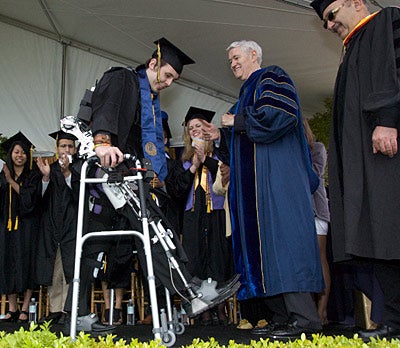Paraplegic College Grad Lands His First Job: A Bionic Leg Tester
Jobs of the future

After walking across the stage at his graduation with the help of exoskeletal legs, Austin Whitney strolled straight into a new career: bionic leg tester.
Before he starts law school next fall, the recent University of California-Berkeley graduate is working for the team who designed his robotic exoskeleton, named Austin in his honor. He spent nine months honing the design before his May 14 graduation, and he has been continuing his work, helping technicians make continual adjustments and refinements. CNET describes Whitney’s new gig, in which he is paid to spend about six hours a day testing the bionic legs.
On a typical day, Whitney is attached to a tether cable to prevent him from falling, and he completes two tests in the suit, walking around the lab of lab of mechanical engineering professor Homayoon Kazerooni. He is paid to help the engineers test new gaits, walker strategies and new components, CNET says. The goal is to produce a prototype device that can help any person with a spinal cord injury.
Whitney was in prime physical shape when he crashed into a tree in 2007, leaving his legs paralyzed, and his upper-body strength remains an advantage — he can lift himself out of his wheelchair and attach himself to the suit. The 40-pound suit is powered by a battery the user wears like a backpack, and a computer that drives the actuators that move the legs.
Kazerooni is also the founder of Berkeley Bionics, which is producing the eLEGS exoskeleton, itself modeled after Lockheed Martin’s HULC military exoskeleton. The eLEGS will be offered to rehabilitation centers for use under medical supervision, but a suit modeled after Austin’s would be simpler and cheaper, and ideally easier to use.
“We want to make the Model T version of an exoskeleton,” Whitney told CNET.